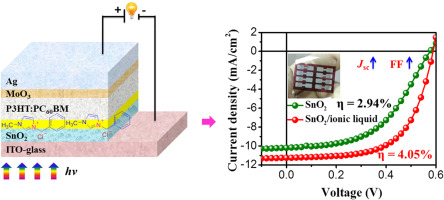当前位置:
X-MOL 学术
›
Sol. Energy Mater. Sol. Cells
›
论文详情
Our official English website, www.x-mol.net, welcomes your feedback! (Note: you will need to create a separate account there.)
Low-temperature solution-processed ionic liquid modified SnO 2 as an excellent electron transport layer for inverted organic solar cells
Solar Energy Materials and Solar Cells ( IF 6.9 ) Pub Date : 2018-06-01 , DOI: 10.1016/j.solmat.2017.12.013 Van-Huong Tran , Rizwan Khan , In-Hwan Lee , Soo-Hyoung Lee
Solar Energy Materials and Solar Cells ( IF 6.9 ) Pub Date : 2018-06-01 , DOI: 10.1016/j.solmat.2017.12.013 Van-Huong Tran , Rizwan Khan , In-Hwan Lee , Soo-Hyoung Lee

|
Abstract SnO 2 with its excellent properties such as high optical transparency, suitable band energy and high electron mobility, recently has received special attention from researchers as an outstanding electron transport layer (ETL) for optoelectronic devices. Here, we demonstrate that SnO 2 combined with ionic liquid (IL), 1-benzyl-3-methylimidazolium chloride ([BzMIM]Cl), based on low-temperature solution-processed can be an excellent ETL for efficient inverted organic solar cells (iOSCs). Our best performance with P3HT:PC 60 BM based iOSCs using SnO 2 /IL as an ETL, has achieved a power conversion efficiency (PCE) of 4.05%, which is the highest reported value so far and was a 38% increase compared to that of SnO 2 only (2.94%). Using ultraviolet photoelectron spectroscopy, we found that the work function of the cathode decreased significantly from − 4.38 eV to − 3.82 eV for SnO 2 /IL, an outstanding feature that is necessary for an ideal ETL. Electrochemical impedance spectroscopy studies revealed a significant lower transport resistance and an efficient charge extraction at the interface between photoactive layer and the electrode for the SnO 2 /IL-based iOSC than for the SnO 2 only device. The iOSC devices using SnO 2 /IL showed excellent long-term stability, with a PCE of ~ 81% compared to the initial value after storage for 2.5 months in ambient conditions. This low-temperature solution-processed SnO 2 /IL is expected for low-cost, high throughput, roll-to-roll process on flexible substrates for iOSC as well as other optoelectronic devices.
中文翻译:

低温溶液处理的离子液体改性SnO 2 作为倒置有机太阳能电池的优异电子传输层
摘要 SnO 2 以其高透光率、合适的能带能量和高电子迁移率等优异性能,作为光电器件的优秀电子传输层(ETL)近年来受到了研究人员的特别关注。在这里,我们证明了基于低温溶液处理的 SnO 2 与离子液体 (IL)、1-苄基-3-甲基咪唑氯化物 ([BzMIM]Cl) 相结合,可以成为高效倒置有机太阳能电池的优异 ETL( iOSC)。我们使用 SnO 2 /IL 作为 ETL 的基于 P3HT:PC 60 BM 的 iOSC 的最佳性能实现了 4.05% 的功率转换效率 (PCE),这是迄今为止报告的最高值,相比之下提高了 38%仅 SnO 2 (2.94%)。利用紫外光电子能谱,我们发现对于 SnO 2 /IL,阴极的功函数从 - 4.38 eV 显着降低到 - 3.82 eV,这是理想 ETL 所必需的突出特征。电化学阻抗谱研究表明,与仅使用 SnO 2 的器件相比,基于 SnO 2 /IL 的 iOSC 在光敏层和电极之间的界面处具有显着更低的传输电阻和有效的电荷提取。使用 SnO 2 /IL 的 iOSC 设备显示出出色的长期稳定性,与在环境条件下储存 2.5 个月后的初始值相比,PCE 约为 81%。这种低温溶液处理的 SnO 2 /IL 有望用于 iOSC 和其他光电设备的柔性基板上的低成本、高吞吐量、卷对卷工艺。一个理想的 ETL 所必需的杰出特性。电化学阻抗谱研究表明,与仅使用 SnO 2 的器件相比,基于 SnO 2 /IL 的 iOSC 在光敏层和电极之间的界面处具有显着更低的传输电阻和有效的电荷提取。使用 SnO 2 /IL 的 iOSC 设备显示出出色的长期稳定性,与在环境条件下储存 2.5 个月后的初始值相比,PCE 约为 81%。这种低温溶液处理的 SnO 2 /IL 有望用于 iOSC 和其他光电设备的柔性基板上的低成本、高吞吐量、卷对卷工艺。一个理想的 ETL 所必需的杰出特性。电化学阻抗谱研究表明,与仅使用 SnO 2 的器件相比,基于 SnO 2 /IL 的 iOSC 在光敏层和电极之间的界面处具有显着更低的传输电阻和有效的电荷提取。使用 SnO 2 /IL 的 iOSC 设备显示出出色的长期稳定性,与在环境条件下储存 2.5 个月后的初始值相比,PCE 约为 81%。这种低温溶液处理的 SnO 2 /IL 有望用于 iOSC 和其他光电设备的柔性基板上的低成本、高吞吐量、卷对卷工艺。电化学阻抗谱研究表明,与仅使用 SnO 2 的器件相比,基于 SnO 2 /IL 的 iOSC 在光敏层和电极之间的界面处具有显着更低的传输电阻和有效的电荷提取。使用 SnO 2 /IL 的 iOSC 设备显示出出色的长期稳定性,与在环境条件下储存 2.5 个月后的初始值相比,PCE 约为 81%。这种低温溶液处理的 SnO 2 /IL 有望用于 iOSC 和其他光电设备的柔性基板上的低成本、高吞吐量、卷对卷工艺。电化学阻抗谱研究表明,与仅使用 SnO 2 的器件相比,基于 SnO 2 /IL 的 iOSC 在光敏层和电极之间的界面处具有显着更低的传输电阻和有效的电荷提取。使用 SnO 2 /IL 的 iOSC 设备显示出出色的长期稳定性,与在环境条件下储存 2.5 个月后的初始值相比,PCE 约为 81%。这种低温溶液处理的 SnO 2 /IL 有望用于 iOSC 和其他光电设备的柔性基板上的低成本、高吞吐量、卷对卷工艺。在环境条件下 5 个月。这种低温溶液处理的 SnO 2 /IL 有望用于 iOSC 和其他光电设备的柔性基板上的低成本、高吞吐量、卷对卷工艺。在环境条件下 5 个月。这种低温溶液处理的 SnO 2 /IL 有望用于 iOSC 和其他光电设备的柔性基板上的低成本、高吞吐量、卷对卷工艺。
更新日期:2018-06-01
中文翻译:

低温溶液处理的离子液体改性SnO 2 作为倒置有机太阳能电池的优异电子传输层
摘要 SnO 2 以其高透光率、合适的能带能量和高电子迁移率等优异性能,作为光电器件的优秀电子传输层(ETL)近年来受到了研究人员的特别关注。在这里,我们证明了基于低温溶液处理的 SnO 2 与离子液体 (IL)、1-苄基-3-甲基咪唑氯化物 ([BzMIM]Cl) 相结合,可以成为高效倒置有机太阳能电池的优异 ETL( iOSC)。我们使用 SnO 2 /IL 作为 ETL 的基于 P3HT:PC 60 BM 的 iOSC 的最佳性能实现了 4.05% 的功率转换效率 (PCE),这是迄今为止报告的最高值,相比之下提高了 38%仅 SnO 2 (2.94%)。利用紫外光电子能谱,我们发现对于 SnO 2 /IL,阴极的功函数从 - 4.38 eV 显着降低到 - 3.82 eV,这是理想 ETL 所必需的突出特征。电化学阻抗谱研究表明,与仅使用 SnO 2 的器件相比,基于 SnO 2 /IL 的 iOSC 在光敏层和电极之间的界面处具有显着更低的传输电阻和有效的电荷提取。使用 SnO 2 /IL 的 iOSC 设备显示出出色的长期稳定性,与在环境条件下储存 2.5 个月后的初始值相比,PCE 约为 81%。这种低温溶液处理的 SnO 2 /IL 有望用于 iOSC 和其他光电设备的柔性基板上的低成本、高吞吐量、卷对卷工艺。一个理想的 ETL 所必需的杰出特性。电化学阻抗谱研究表明,与仅使用 SnO 2 的器件相比,基于 SnO 2 /IL 的 iOSC 在光敏层和电极之间的界面处具有显着更低的传输电阻和有效的电荷提取。使用 SnO 2 /IL 的 iOSC 设备显示出出色的长期稳定性,与在环境条件下储存 2.5 个月后的初始值相比,PCE 约为 81%。这种低温溶液处理的 SnO 2 /IL 有望用于 iOSC 和其他光电设备的柔性基板上的低成本、高吞吐量、卷对卷工艺。一个理想的 ETL 所必需的杰出特性。电化学阻抗谱研究表明,与仅使用 SnO 2 的器件相比,基于 SnO 2 /IL 的 iOSC 在光敏层和电极之间的界面处具有显着更低的传输电阻和有效的电荷提取。使用 SnO 2 /IL 的 iOSC 设备显示出出色的长期稳定性,与在环境条件下储存 2.5 个月后的初始值相比,PCE 约为 81%。这种低温溶液处理的 SnO 2 /IL 有望用于 iOSC 和其他光电设备的柔性基板上的低成本、高吞吐量、卷对卷工艺。电化学阻抗谱研究表明,与仅使用 SnO 2 的器件相比,基于 SnO 2 /IL 的 iOSC 在光敏层和电极之间的界面处具有显着更低的传输电阻和有效的电荷提取。使用 SnO 2 /IL 的 iOSC 设备显示出出色的长期稳定性,与在环境条件下储存 2.5 个月后的初始值相比,PCE 约为 81%。这种低温溶液处理的 SnO 2 /IL 有望用于 iOSC 和其他光电设备的柔性基板上的低成本、高吞吐量、卷对卷工艺。电化学阻抗谱研究表明,与仅使用 SnO 2 的器件相比,基于 SnO 2 /IL 的 iOSC 在光敏层和电极之间的界面处具有显着更低的传输电阻和有效的电荷提取。使用 SnO 2 /IL 的 iOSC 设备显示出出色的长期稳定性,与在环境条件下储存 2.5 个月后的初始值相比,PCE 约为 81%。这种低温溶液处理的 SnO 2 /IL 有望用于 iOSC 和其他光电设备的柔性基板上的低成本、高吞吐量、卷对卷工艺。在环境条件下 5 个月。这种低温溶液处理的 SnO 2 /IL 有望用于 iOSC 和其他光电设备的柔性基板上的低成本、高吞吐量、卷对卷工艺。在环境条件下 5 个月。这种低温溶液处理的 SnO 2 /IL 有望用于 iOSC 和其他光电设备的柔性基板上的低成本、高吞吐量、卷对卷工艺。



























 京公网安备 11010802027423号
京公网安备 11010802027423号